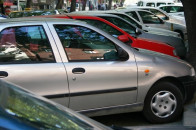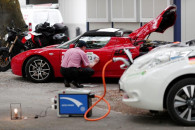Security the perimeter: French embassy asked to push back encroaching wall
CDA directs foreign ministry to get movable structure shifted; embassy in touch with ministry, civic agency.

Despite being housed in one of the most secure areas of Islamabad, a foreign mission seems to be taking no chances when it comes to security.
A movable security wall around the French Embassy in the Diplomatic Enclave has been placed beyond the permissible limits and has created a minor dispute between the embassy, the capital’s civic agency and the Ministry of Foreign Affairs.
Given the situation, the Capital Development Authority, after investigating the issue, has requested the Foreign Ministry inform the French Embassy about the violation and ask it to move the wall back within permissible limits.
Correspondence between the parties on the issue, copies of which are available with The Express Tribune, says the embassy has set up the security wall almost 70-feet from the permissible limit and that the wall encroaches upon the right-of-way of Constitution Avenue.
Nature of violation
According to the most recent letter, the issue was brought to the notice of the CDA by the ministry itself through a letter dated August 5, 2014. The CDA was directed in the earlier letter to visit the embassy and determine the extent of the encroachment.
Consequently, the area was inspected by the ministry’s protocol deputy chief and the CDA Protocol deputy director on September 15, 2014, all in the presence of a representative of the embassy.
The violations stem from a time in 2012, when several foreign missions including the French Embassy were granted special permissions to erect bomb-proof security walls, commonly known as T-barriers, along their premises in a bid to enhance the security of these buildings.
The letter states that the inspection team observed that in violation of the CDA’s earlier permission, the French Embassy has “constructed a security wall almost 70 feet away from the western boundary wall of the embassy by encroaching upon the right-of-way of Constitution Avenue.
The CDA mentioned that this violates three separate clauses of the earlier permission agreement.
On October 17, the CDA requested that the foreign ministry intimate the French Embassy to push back the wall.
A senior officer at the CDA says the violation has yet to be rectified; even though the ministry has served a notice to the embassy.
The source further claimed that the embassy administration did not deny fault, but instead wanted the rules to be enforced across the board as it was not the only violator.
The officer said that almost 60 percent of embassies had gone beyond permissible limits while placing security walls along their respective premises. “The violation at the French Embassy was more noticeable because it is relatively larger,” he commented.
In response to a request for comment on the issue, Aqeel Hussain, a media wing official at the embassy, did not confirm or deny the issue, only saying that, “The Embassy of France is in contact with [the Foreign Ministry] and the CDA over the issue”.
CDA spokesperson Asim Khichi said that under diplomatic protocols, the CDA could not directly interact with the embassy and had to go through the ministry. He said issue had been brought to the notice of the ministry so that it could be resolved amicably.
Dime a dozen
Violations of land use norms by foreign missions in Islamabad are nothing new. A recently compiled list of non-conforming use of residential units by the CDA lists 19 foreign missions operating embassies in residential areas, even though CDA laws do not allow for this.
Out of the 19, some four are located in the G-series of sectors, while the other 15 are in the F-series sectors. These embassies include Lebanon, Cuba, the Czech Republic, Denmark, Greece, Ukraine, Jordan, Kazakhstan, Azerbaijan, Oman, Afghanistan, Romania, Bahrain, Jordan, South Africa and Brazil.
Some of these foreign missions have not only erected illegal structures along their boundary walls, but also closed adjoining streets, creating headaches for local residents and passersby.
Published in The Express Tribune, November 14th, 2014.



















COMMENTS
Comments are moderated and generally will be posted if they are on-topic and not abusive.
For more information, please see our Comments FAQ